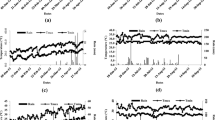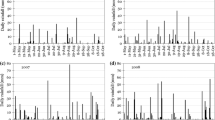Abstract
In arid and semiarid environments, with shortage of water resources, maize production is competing for available water. This study analyzed the effect of different irrigation systems on maize yield, crop evapotranspiration and its components, i.e., canopy transpiration (T) and soil evaporation (E). A 2-year field experiment was conducted at the ITAP Research facilities located in Albacete (southeast Spain). Four treatments were assessed: surface drip irrigation with a spacing between drip lines of 1.5 m (SDI_1.5) and 0.75 m (SDI_0.75); subsurface drip irrigation (SubDI); solid set sprinkler irrigation (Sprink). In all treatments, irrigation was applied to refill the estimated potential water demand. Crop evapotranspiration (ETc) and E/T partitioning were estimated using a Simplified Two-Source Energy Balance (STSEB) approach. Although there was an important difference in the irrigation water applied between treatments, ranging from 743 and 722 for Sprink system to 534 and 495 for SubDI system in 2014 and 2015, respectively, yield was unaffected by the irrigation regime, resulting in an increase in the irrigation water productivity (IWP) by an average of 25% when irrigation was applied by the subsurface system. Maize ETc was affected by the irrigation system, with the SubDI achieving in 2015 a 39% reduction of seasonal ETc in comparison with the Sprink system. Similar reductions were obtained for separated E and T components with soil evaporation accounting in general for 15–20% of the total ETc. It is concluded that subsurface irrigation is a water savings strategy for irrigation of maize reducing the consumptive water use and increasing IWP. The final convenience for the widespread adoption of subsurface irrigation will depend on water availability and prices.






Similar content being viewed by others
References
Abd El-Wahed MH, Ali EA (2013) Effect of irrigation systems, amounts of irrigation water and mulching on corn yield, water use efficiency and net profit. Agric Water Manag 120:64–71
Allen RG, Pereira LS, Raes D, Smith M (1998) Crop evapotranspiration. Guidelines for computing crop water requirements. FAO Irrigation and Drainage, Paper 56, FAO, Rome
AQUASTAT (2015) FAO’s Global Information System on Water and Agriculture (online), Consultation. http://www.fao.org/nr/water/aquastat/data/query/index.html?lang=en. Accessed 10 Jun 2019
Bozkurt Y, Yazar A, Gençel B, Sezen MS (2006) Optimum lateral spacing for drip-irrigated corn in the Mediterranean Region of Turkey. Agric Water Manag 85:113–120
Bu LD, Liu JL, Zhu L, Luo SS, Chen XP, Li SQ, Hill R, Zhao Y (2013) The effects of mulching on maize growth, yield and water use in a semi-arid region. Agric Water Manag 123:71–78
Chávez JL, López-Urrea R (2019) One-step approach for estimating maize actual water use: part I. Modeling a variable surface resistance. Irrig Sci 37:123–137
CIHEAM. 2015. Statistical review. Agriculture, Food security, Society, Environment (online), Consultation. https://www.ciheam.org/uploads/attachments/70/CIHEAM_Statistical_Review_2015.pdf. Accessed 10 Jun 2019
Cihlar J, Dobson MC, Schmugge T, Hoogeboom P, Janse ARP, Baret F, Guyot G, Le Toan T, Pampaloni P (1987) Procedures for the description of agricultural crops and soils in optical and microwave remote sensing studies. Int J Rem Sens 8:427–439
Colaizzi PD, Kustas WP, Anderson MC, Agam N, Tolk JA, Evett SR, Howell TA, Gowda PH, O´Shaughnessy SA (2012) Two-source energy balance model estimates of evapotranspiration using component and composite surface temperatures. Adv Water Resour 50:134–151
El-Hendawy SE, Add El-Lattief EA, Ahmed MS, Schmidhalter U (2008) Irrigation rate and plant density effects on yield and water use efficiency of drip-irrigated corn. Agric Water Manag 95:836–844
Exelis Visual Information Solutions (2012) ENVI User’s Guide. Boulder, Colorado: Exelis Visual Information Solutions, pages used, Boulder, CO
FAOSTAT (2017) FAO Statistical Database (online), Consultation. http://www.fao.org/faostat/en/#data/QC. Accessed 14 Jun 2019
Fereres E, Goldhamer DA, Parsons LA (2003) Irrigation water management of horticultural crops. HortSci 38:1036–1042
Hassanli AM, Ebrahimizadeh MA, Beecham S (2009) The effects of irrigation methods with effluent and irrigation scheduling on water use efficiency and corn yields in an arid region. Agric Water Manag 96:93–99
Hsiao TC, Fereres E (2012) Maize. In: Steduto P et al (eds) Crop yield responses to water stress, Paper 66. FAO, Rome, pp 114–120
IPCC (2018) Summary for Policymakers. In: Global warming of 1.5 °C. An IPCC Special Report on the impacts of global warming of 1.5 °C above pre-industrial levels and related global greenhouse gas emission pathways, in the context of strengthening the global response to the threat of climate change, sustainable development, and efforts to eradicate poverty. Masson-Delmotte V, Zhai P, Pörtner HO, Roberts D, Skea J, Shukla PR, Pirani A, Moufouma-Okia W, Péan C, Pidcock R, Connors S, Matthews JBR, Chen Y, Zhou X, Gomis MI, Lonnoy E, Maycock T, Tignor M, Waterfield T (eds) World Meteorological Organization, Geneva, Switzerland, p 32
Kustas WP, Alfieri JG, Anderson MC, Colaizzi PD, Prueger JH, Evett SR, Neale CMU, French AN, Hipps LE, Chávez JL, Copeland KS, Howell TA (2012) Evaluating the two-source energy balance model using local thermal and surface flux observations in a strongly advective irrigated agricultural area. Adv Water Resour 50:120–133
Lamm FR, Stone LR, Manges HL, O´Brian DM (1997) Optimum lateral spacing for subsurface drip-irrigated corn. Trans ASAE 40(4):1021–1027
López-Urrea R, de Santa Martín, Olalla F, Fabeiro C, Moratalla A (2006) Testing evapotranspiration equations using lysimeter observations in a semiarid climate. Agric Water Manag 85:15–26
López-Urrea R, Martínez-Molina L, de la Cruz F, Montoro A, González-Piqueras J, Odi-Lara M, Sánchez JM (2016) Evapotranspiration and crop coefficients of irrigated biomass sorghum for energy production. Irrig Sci 34:287–296
Payero JO, Tarkalson DD, Irmak S, Davison D, Petersen JL (2008) Effect of irrigation amounts applied with subsurface drip irrigation on corn evapotranspiration, yield, water use efficiency, and dry matter production in a semiarid climate. Agric Water Manag 95:895–908
Ritchie SW, Hanway JJ (1982) How a corn plant develops. Special Report No. 48, Iowa State University of Science and Technology, Cooperative Extension Service
Rodrigues GC, Paredes P, Gonçalves JM, Alves I, Pereira LS (2013) Comparing sprinkler and drip irrigation systems for full and deficit irrigated maize using multicriteria analysis and simulation modelling: ranking for water saving vs. farm economic return. Agric Water Manag 126:85–96
Rubio E, Caselles V, Coll C, Valor E, Sospedra F (2003) Thermal-infrared emissivities of natural surfaces: improvements on the experimental set-up and new measurements. Int J Remote Sens 24:5379–5390
Sánchez JM, Kustas WP, Caselles V, Anderson M (2008) Modelling surface energy fluxes over maize using a two-source patch model and radiometric soil and canopy temperature observations. Remote Sens Environ 112:1130–1143
Sánchez JM, López-Urrea R, Rubio E, Caselles V (2011) Determining water use of sorghum from two-source energy balance and radiometric temperatures. Hydrol Earth Syst Sci 15:3061–3070
Sánchez JM, López-Urrea R, Rubio E, González-Piqueras J, Caselles V (2014) Assessing crop coefficients of sunflower and canola using two-source energy balance and thermal radiometry. Agric Water Manag 137:23–29
Sánchez JM, López-Urrea R, Doña C, Caselles V, González-Piqueras J, Niclós R (2015) Modeling evapotranspiration in a spring wheat from termal radiometry: crop coefficients and E/T partitioning. Irrig Sci 33:399–410
Sánchez JM, López-Urrea R, Valentín F, Caselles V, Galve J (2019) Lysimeter assessment of the simplified two-source energy balance model and eddy covariance system to estimate vineyard evapotranspiration. Agric For Meteorol 274:172–183
Soil Survey Staff (2014) Keys to soil taxonomy, 12th edn. USDA-Natural Resources Conservation Service, Washington, DC
Trigo IF, de Bruin H, Beyrich F, Bosveld FC, Gavilán P, Groh J, López-Urrea R (2018) Validation of reference evapotranspiration from Meteosat Second Generation (MSG) observations. Agric For Meteorol 259:271–285
Trout TJ, DeJonge KC (2017) Water productivity of maize in the US high plains. Irrig Sci 35:251–266
Trout TJ, DeJonge KC (2018) Crop water use and crop coefficients of maize in the great plains. J Irrig Drain Eng 144(6):04018009
Acknowledgments
This work has been funded by the Spanish Ministry of Economy and Competitiveness (Project IPT-2012-0480-310000). The authors are particularly grateful to H. Picazo and J.A. de la Vara for their help during the fieldwork and data collection phase.
Author information
Authors and Affiliations
Corresponding author
Ethics declarations
Conflict of interest
On behalf of all authors, the corresponding author states that there is no conflict of interest.
Additional information
Communicated by Ray G Anderson.
Publisher's Note
Springer Nature remains neutral with regard to jurisdictional claims in published maps and institutional affiliations.
Rights and permissions
About this article
Cite this article
Valentín, F., Nortes, P.A., Domínguez, A. et al. Comparing evapotranspiration and yield performance of maize under sprinkler, superficial and subsurface drip irrigation in a semi-arid environment. Irrig Sci 38, 105–115 (2020). https://doi.org/10.1007/s00271-019-00657-z
Received:
Accepted:
Published:
Issue Date:
DOI: https://doi.org/10.1007/s00271-019-00657-z




